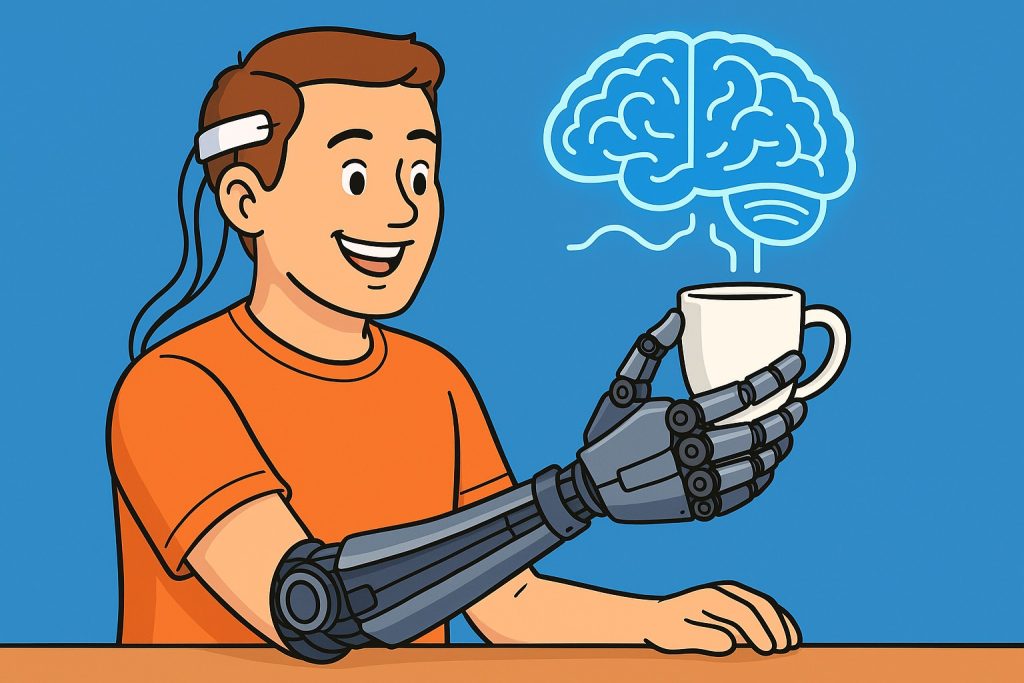Prosthetics have come a long way from simple wooden limbs to advanced robotic arms and legs. But the future holds something even more groundbreaking: brain-controlled prosthetics that respond directly to a user’s thoughts. These innovations promise to restore lost mobility and independence in ways once thought possible only in science fiction.
How Brain-Controlled Prosthetics Work
At the heart of this technology is the interface between the brain and the machine — a system often called a Brain-Computer Interface (BCI). BCIs decode the electrical signals generated by neurons and translate them into commands that control a robotic limb.
There are two primary methods of capturing brain signals:
- Invasive BCIs involve implanting electrodes directly into the brain. They provide precise readings but carry surgical risks.
- Non-invasive BCIs use external sensors like EEG caps to record brain activity through the scalp. While safer, these systems tend to be less accurate and slower.
Once the signals are captured, machine learning algorithms analyze them to predict the user’s intended movements. The prosthetic then executes the action — such as grasping a cup or walking forward — in real-time.
Adding Sensation: The Role of Sensory Feedback
Movement is only half the equation. For a prosthetic to truly feel like part of the body, users need to receive sensory feedback. Cutting-edge prototypes now include sensors that detect pressure or texture and send this information back to the nervous system, often via electrical stimulation of remaining nerves or the spinal cord.
This feedback helps wearers adjust their grip strength, balance, and coordination, making the prosthetic feel more natural and improving safety during use.
Real-World Progress
Several real-world cases demonstrate the potential of brain-machine-controlled prosthetics:
- In 2021, researchers at the University of Pittsburgh developed a robotic arm that allowed a paralyzed man to feed himself using only his thoughts.
- In 2023, an Austrian startup unveiled a leg prosthesis with embedded sensors and a brain-interface module, enabling near-natural walking and balance correction.
- Ongoing clinical trials are exploring how these systems can help stroke victims regain control over affected limbs.
Challenges Ahead
Despite promising progress, brain-controlled prosthetics still face several hurdles:
- Cost: Advanced prosthetics are expensive to produce and maintain.
- Training: Users often need weeks or months to learn how to control the device effectively.
- Durability: Sensitive electronics and sensors must be rugged enough for daily use.
- Ethics and Privacy: As BCIs collect neurological data, concerns arise over data security and autonomy.
What the Future Holds
Looking ahead, researchers are working to improve signal accuracy, reduce training time, and miniaturize components for better comfort. We may also see:
- Wireless BCIs that eliminate the need for bulky hardware.
- AI-enhanced prediction models that learn faster and adapt to users’ preferences.
- Integration with augmented reality (AR) to provide visual cues and control options.
- Bio-hybrid limbs with muscle and nerve tissue grown from the patient’s own cells.
The goal is not just to restore function, but to enhance it — giving people abilities beyond what natural limbs can provide.
Glossary
- Brain-Computer Interface (BCI) – A system that translates brain activity into machine commands.*
- Invasive BCI – A type of BCI that requires implanting electrodes into the brain.*
- Non-invasive BCI – A BCI that reads brain signals from outside the skull, usually via EEG.*
- Sensory Feedback – The process of sending information (e.g., pressure or temperature) back to the user through the nervous system.*
- Machine Learning – A type of artificial intelligence that improves through experience without being explicitly programmed.*


